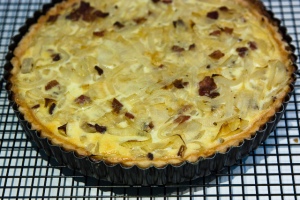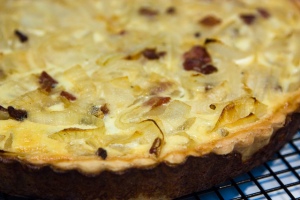I still had most of a 5lb bag of Texas 1015 sweet onions left from my farmers market trip several weeks ago, so I began thinking through recipes that would work through those onions. Me and certain kinds of butter-heavy pastry dough have not gotten on too well in the past, but I figured a nice luxurious onion tarte might be just the thing to use up some of my sweet onion bounty.
I made the dough (the French kids would call it a pate brisee) for the tarte by first mixing about 1 ½ cups of flour with ½ t salt, 6 T cold butter, and 3T cold shortening. I worked these with my fingertips until the mixture looked like a coarse meal. It seems that the best method for doing this is to sort of pinch your fingers through the fat and flour sort of mashing the big pieces into smaller and smaller chunks. You do not want to fully incorporate the fat - there should be visible chunks still remaining. Next I sprinkled in about 4 T ice water, and worked this in lightly with a fork. To test if enough water has been added to the fat and flour, take a handful of the crumbles and squeeze them in your hand. If they hold together, the dough’s in good shape. If you overwork the dough, it will become tough, so less is definitely more here. I then shaped the dough into a 5"-6" disc, wrapped it in plastic wrap, and let it cool and harden in the refrigerator for about an hour (with that much fat in the dough, this step is absolutely required, otherwise you would not so much be rolling it out as spreading it like sticky peanut butter on your counter).
The dough was brought out of the refrigerator to be rolled out on a floured counter top with a floured rolling pin. It is best to work quickly here - the dough will be the most manageable while the fats are still relatively hard. I rolled it out such that its edges overhung my tarte pan, which is roughly 9 ½ inches in diameter and roughly 1 inch tall. Using my rolling pin (to sort of spool the dough onto) and a bench scraper (to scrape at the stick bits) as aids, I carefully moved the rolled out tarte dough to the tarte pan began to work it in. Using my fingers to lightly press the dough into the pan, I pushed the dough into all the nooks and crannies sufficiently and reinforced the sides of the tarte somewhat with the scraps that overhung the edge of the pan. Finally, I carefully docked (poked holes to keep the crust from bubbling) the bottom of the crust with a fork and placed in the refrigerator to harden for about half an hour.
The oven was then preheated to 400 degrees (F). I wrapped the tarte crust in aluminum foil, weighed it down with pie weights (or in my case, dried beans), then placed it on a baking sheet (to make it easier to move the tarte around and to catch any overflow) and baked for roughly 15-20 inutes, just until the crust began to color a bit. Once the crust looked good, I removed the foil and weights and continued baking the crust for another 10-15 minutes, allowing it to crisp up and become golden.
While the tarte shell was baking, I worked on the filling. I cut up 3-4 oz of guanciale (an Italian bacon not unlike pancetta in that it is not smoked … guanciale is unique in that it is made from the pig’s cheeks instead of its belly), sliced about 1/8" thick, into ½" x ½" pieces, then sauteed these in a 12" nonstick skillet over medium high heat until all the pieces were crispy and the fat had rendered from them. I moved the guanciale to a paper towel lined plate to drain, and then spooned all but about 1 ½ T of the rendered fat from the pan. To this, I added about 1 T olive oil and about 8 cups of Texas 1015 sweet onions, cut in half and sliced thinly. I cooked these over medium heat until they were translucent. Then I added about ½ t each kosher salt and pepper and continued cooking for about a half an hour. When finished the onions were very soft and golden-amber in color. I mixed the crispy guanciale pieces into the oinions and set the mixture aside to cool a bit.
In a separate bowl, I mixed 6 oz of creme fraiche and 3 whole large eggs. This was whipped to combine and then the cooled onion mixture was stirred in. Once the prepared tart shell came from the oven and cooled for a couple minutes, I carefully poured in the tarte filling. This was almost exactly the right amount of filling for the tarte, and if I had carefully scooped in the solids first, spread them out, and then poured the remaining liquid over, everything might’ve been fine. Unfortunately, I dumped the whole works in and then had to figure out how to level out the tarte filling. As it turns out, I did this by sloshing egg mixture into the small space that had developed between the very beautiful tarte crust and the tarte pan.

This was baked for about 25 minutes and removed to cool. The tarte came cleanly from its pan, and the parts of the crust that were visible were just beautiful. Unfortunately, most of the pretty crust was lined with an interesting layer of browned egg and creme fraiche binder. (Reference the photo below where a tiny bit of my beautiful crust is just peeking out of the dark brown binder.)

The tart was incredibly tasty though. The buttery crust was flaky and light, yet held up well to the heavy filling. The onions were sublimely sweet and paired nicely with the very salty guanciale. And best of all, there are leftovers for a couple of lunches yet too. To me, the tarte is best served warm, but it could be served at room temperature as well. Now, only about 3 lbs of onions to go …